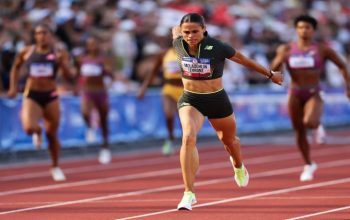In recent decades, the world has witnessed a transformative shift in the landscape of professional sports. Once dominated almost exclusively by men, the playing field is now evolving—slowly but unmistakably—to include women at the highest levels of competition, influence, and visibility. The rise of women in professional sports is not just a trend; it’s a movement that is breaking barriers, reshaping media narratives, and inspiring generations of athletes and fans alike.
From commanding multimillion-dollar sponsorship deals to headlining global events, female athletes are proving that they are just as skilled, marketable, and influential as their male counterparts. This article explores how women have risen in professional sports, the challenges they continue to face, and the groundbreaking milestones they’ve achieved along the way.
A Historical Perspective
Historically, women’s participation in professional sports was limited by social norms, legal restrictions, and institutional barriers. For much of the 20th century, sports were considered a male domain, and women’s involvement was often relegated to recreational levels.
It wasn’t until 1972, with the passage of Title IX in the United States, that educational institutions were required to provide equal opportunities in sports. This pivotal moment laid the groundwork for future generations of female athletes, especially in the U.S., where the effects are still evident today.
Milestones in Women’s Sports
Women have reached impressive milestones in almost every major sport. A few standout examples include:
- Serena Williams dominating tennis with 23 Grand Slam singles titles, redefining athleticism and motherhood in sports.
- Simone Biles revolutionizing gymnastics with unprecedented routines and mental health advocacy.
- Megan Rapinoe and the USWNT (U.S. Women’s National Soccer Team) winning the FIFA World Cup while campaigning for equal pay and social justice.
- Katie Ledecky setting world records in swimming, while also promoting educational initiatives for young athletes.
- Ronda Rousey and Amanda Nunes elevating women’s mixed martial arts to main-event status in the UFC.
These athletes have not only succeeded individually but have pushed their sports forward, generating greater interest, higher viewership, and more robust economic support.
Media and Marketability
Media coverage of women’s sports has long lagged behind men’s. According to multiple studies, women’s sports receive only about 4% of all sports media coverage. However, this narrative is changing.
Thanks to social media, streaming platforms, and dedicated sports networks, women athletes now have direct access to their fans and control over their personal brands. Athletes like Naomi Osaka and Alex Morgan have amassed massive followings and signed multimillion-dollar endorsement deals with companies like Nike, Adidas, and Visa.
Additionally, events such as the Women’s World Cup, WNBA Finals, and Olympic competitions have drawn record-breaking audiences, demonstrating that there is a significant market for women’s sports when they are promoted effectively.
Investment and Sponsorship Growth
The commercial viability of women’s sports is gaining recognition. Brands are increasingly investing in female athletes and leagues, not only because it aligns with social values but also because it makes financial sense.
For instance:
- In 2022, Visa announced it would match its sponsorship of the UEFA Women’s Champions League with that of the men’s competition.
- The WNBA secured a major investment round in 2022 that brought its valuation to over $1 billion, signaling long-term commercial growth.
- Angel City FC, a women’s soccer club in Los Angeles, made headlines with its celebrity investors and sold-out home games.
Such developments signal a growing belief that women’s sports are not just worthy of investment—they are smart business.
Global Momentum
The rise of women in professional sports is not confined to the U.S. or Western nations. Around the world, female athletes are gaining prominence.
- In cricket, countries like India, Australia, and England are investing heavily in women’s leagues, including the newly launched Women’s Premier League (WPL) in India.
- In boxing, fighters like Claressa Shields and Katie Taylor are headlining international bouts and drawing massive pay-per-view audiences.
- In combat sports, Zhang Weili from China and others are breaking regional and cultural barriers to global stardom.
The inclusion of more women’s events in the Olympics, Commonwealth Games, and other global competitions also demonstrates increasing commitment to gender equity in sports.
Challenges That Remain
Despite progress, women still face numerous hurdles in professional sports:
- Pay Disparity: In most sports, female athletes earn significantly less than their male counterparts. Although legal battles and advocacy are making strides, pay gaps remain a central issue.
- Limited Media Exposure: Though improving, coverage remains sparse compared to men’s leagues, which limits sponsorship opportunities and public engagement.
- Lack of Leadership Representation: Women are underrepresented in coaching, ownership, and executive roles within sports organizations.
- Online Abuse and Misogyny: Female athletes often face disproportionate levels of online harassment and criticism, particularly when speaking out on political or social issues.
These challenges must be addressed structurally through policy changes, institutional accountability, and cultural shifts.
The Road Ahead: What’s Next?
The trajectory for women in professional sports is steeply upward. Some key developments expected in the near future include:
- More Women’s Leagues: With success stories like the WNBA and WPL, more countries and sports will launch women’s leagues, creating jobs, visibility, and infrastructure.
- Equity in Broadcasting: As more networks recognize the value of women’s sports, expect greater broadcast parity in major sporting events.
- Corporate Sponsorship: Brands will continue aligning with women’s sports as part of their diversity and equity strategies, leading to bigger and better campaigns.
- Leadership Inclusion: Efforts are being made to promote women into coaching and executive roles, ensuring decisions are made with gender balance in mind.
Conclusion
The rise of women in professional sports is not a fleeting trend—it is a long-overdue reckoning with talent, ambition, and value that has always existed but has too often been overlooked. Today’s female athletes are not just competing—they’re inspiring, innovating, and challenging the very structures that once held them back.
As fans, businesses, and institutions begin to support this movement more meaningfully, we edge closer to a world where the phrase “women in sports” no longer suggests an exception but stands as a celebrated norm.
FAQ: The Rise of Women in Professional Sports
1. Why is there increased attention on women in professional sports today?
The increased attention is driven by several factors, including growing media coverage, the influence of social media, advocacy for gender equality, and the remarkable achievements of female athletes across various sports. These factors have helped spotlight the talent and marketability of women in sports.
2. Which female athletes have played a key role in advancing women’s sports?
Athletes such as Serena Williams, Simone Biles, Megan Rapinoe, Ronda Rousey, Katie Ledecky, and Naomi Osaka have been instrumental. They’ve not only achieved excellence in their respective sports but also used their platforms to advocate for equal pay, representation, and mental health awareness.
3. How are women’s sports being promoted differently today?
Women’s sports are increasingly promoted through dedicated media coverage, social media engagement, streaming platforms, and brand partnerships. Events like the Women’s World Cup and WNBA games are now broadcast more widely, and athletes often connect directly with fans online.
4. Are women’s sports becoming more profitable?
Yes. With increasing sponsorships, viewership, merchandise sales, and investment from sports organizations, women’s sports are proving to be commercially viable. Brands are realizing that supporting female athletes offers both financial return and social impact.
5. What are the main challenges women still face in professional sports?
Key challenges include:
- Pay inequality compared to male athletes
- Limited media coverage
- Underrepresentation in coaching and leadership roles
- Online abuse and gender-based criticism
- Fewer resources and facilities in some sports or regions
6. How has Title IX impacted women in sports?
Title IX, passed in the U.S. in 1972, mandated equal opportunities for women in educational sports programs. It played a critical role in increasing female participation at the collegiate level, which became a feeder system for professional sports careers.
7. What are some promising developments in women’s sports globally?
The launch of professional leagues like the Women’s Premier League (cricket), expanded coverage of women’s soccer, and major investments in female athletes from sponsors and sports bodies are all positive signs. Olympic events also continue to add more categories for female competitors.
8. Can women’s sports reach the same popularity as men’s sports?
Absolutely. With the right investment, visibility, and media support, women’s sports have the potential to reach and even surpass the popularity of some men’s leagues, as seen with record-breaking events like the Women’s World Cup and Lady Gaga’s concert in sporting venues.
9. Why is representation in sports leadership important for women?
Having women in coaching, management, and executive roles ensures more inclusive decision-making and policy development. It also provides role models for future generations and helps address structural inequities in sports organizations.
10. How can fans support women in professional sports?
Fans can support by:
- Watching games and attending events
- Following female athletes and teams on social media
- Purchasing merchandise
- Advocating for equal coverage and funding
- Encouraging youth participation in girls’ sports






